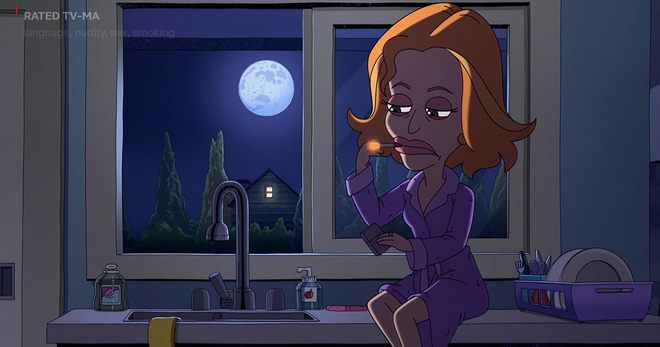
Lights, Camera, Tobacco?
How rising smoking and vaping imagery in top entertainment influences e-cigarette use and fuels nicotine addiction among young audiences.
EXECUTIVE SUMMARY
Truth Initiative’s sixth annual analysis of tobacco imagery in popular entertainment finds increasingly pervasive smoking imagery in 2022’s most popular streaming shows among 15- to 24-year-olds, music videos, as well as youth-rated movies. Truth Initiative, along with research collaborators at Breathe California and NORC at the University of Chicago, has tracked tobacco imagery in entertainment most popular with young people since 2018. This year’s report finds:
- While more than half (53% or 8 out of 15) of the streaming shows most popular with 15- to 24-year-olds contained tobacco imagery – down slightly from 60% of shows during the last two years – the number of tobacco depictions among these shows increased by 110%, or more than doubled, from 425 in 2021 to 890 in 2022, exposing an estimated 25 million young people to tobacco imagery.
- The eight shows with tobacco content among the top 15 were “Dahmer – Monster: The Jeffrey Dahmer Story” (Netflix), “Euphoria” (HBO), “The Simpsons” (Fox), “Stranger Things” (Netflix), “The Walking Dead” (AMC), “Family Guy” (Fox), “Bob’s Burgers” (Fox), and “Law & Order” (NBC). Half of these shows were rated TV-14 and two featured tobacco use by minors.
- Tobacco imagery in top binge-watched shows – those that young people most often reported watching multiple episodes of – nearly quadrupled.
- Tobacco imagery also went up among music videos: twice as many music videos for the most popular songs, according to Billboard charts, portrayed tobacco this year compared to last year (28% vs. 12.8%), and were viewed almost 7 billion times on YouTube as of October 2023.
- While fewer movies released in 2022 contained tobacco imagery compared to 2021 (35% vs. 47%) and the number of depictions were down overall, tobacco depictions increased in PG-rated movies.
- As young people increasingly consume video content via social platforms, a Truth Initiative study currently underway finds that more than a third of 15- to 24-year-olds surveyed who used YouTube reported exposure to tobacco imagery.
On-screen smoking, which is often glamorized and portrayed as edgy and cool, is rising despite well-established research that it influences young people to start using tobacco products. While the youth smoking rate is low, peer-reviewed research from Truth Initiative demonstrates that exposure to smoking imagery in streaming shows can triple a young person’s odds of starting to use e-cigarettes – today’s top tobacco product among young people. This association between tobacco imagery and tobacco product initiation builds on long-established research confirming that exposure to smoking in movies leads young people to start smoking.
More needs to be done to urge decisionmakers at all levels, including entertainment executives and leaders of streaming platforms and broadcast networks, showrunners, directors, writers, actors, and music artists, to refuse to help normalize tobacco and eliminate it on screens most popular with young people.
INTRODUCTION
Truth Initiative’s sixth annual analysis of tobacco imagery in popular entertainment underscores that screens everywhere are inundated with both traditional cigarette and e-cigarette depictions, putting our nation’s youth and young adults at risk. Our analysis finds increasingly pervasive smoking and vaping imagery in 2022’s most popular streaming shows among 15- to 24-year-olds, binge-watched shows, and music videos, as well as youth-rated movies.
Popular streaming shows increased the number of tobacco depictions by 110% – more than double – compared to 2021, exposing nearly 25 million young people to tobacco imagery – no improvement compared to last year. Tobacco imagery also went up among music videos: twice as many music videos for the most popular songs, according to Billboard charts, portrayed tobacco this year compared to last year (28% vs. 12.8%), and were viewed almost 7 billion times on YouTube as of October 2023. Speaking of YouTube, a Truth Initiative study currently underway finds that more than a third of 15- to 24-year-olds surveyed who used YouTube reported exposure to tobacco imagery (see sidebar, page 10). While 35% of movies released in 2022 (40 out of 114) contained tobacco imagery compared to 47% in 2021 (53 out of 112) and the number of depictions were down overall, tobacco depictions increased in PG-rated movies, according to an analysis by NORC at the University of Chicago.
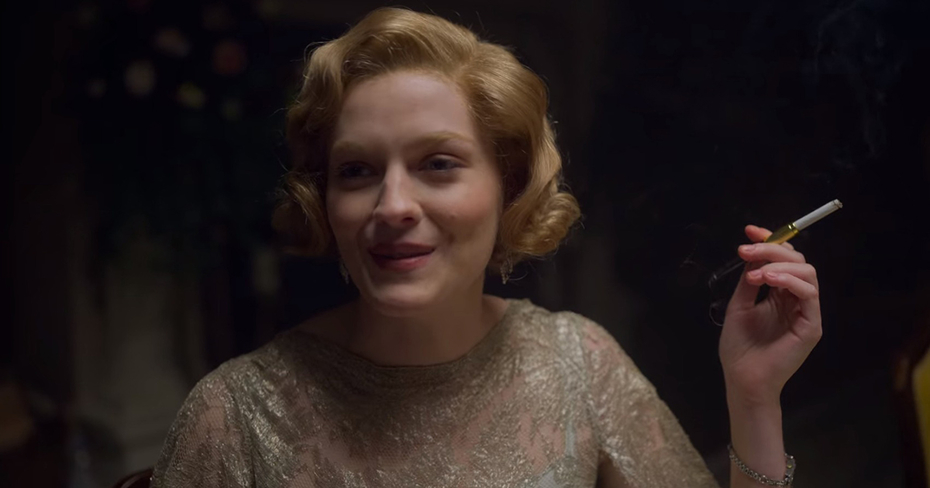
On-screen smoking, which is often glamorized and portrayed as edgy and cool, is rising despite well-established research that it influences young people to start using tobacco products.
On-screen smoking, which is often glamorized and portrayed as edgy and cool, is rising despite well-established research that it influences young people to start using tobacco products. While the youth smoking rate is low, peer-reviewed research from Truth Initiative demonstrates that exposure to smoking imagery in streaming shows can triple a young person’s odds of starting to use e-cigarettes – today’s top tobacco product among young people – building on long-established research confirming that exposure to smoking in movies leads young people to start smoking. The U.S. Surgeon General concluded in 2012 that those with higher levels of exposure to tobacco use in movies are twice as likely to smoke compared with those with less exposure. More needs to be done to urge decisionmakers at all levels, including entertainment executives and leaders of streaming platforms and broadcast networks, showrunners, directors, writers, actors, and music artists, to refuse to help normalize tobacco and eliminate tobacco use and imagery in entertainment content most popular with young people.
Truth Initiative, along with research collaborators at Breathe California and NORC at the University of Chicago, has tracked tobacco imagery in entertainment most popular with young people since 2018. The latest data on tobacco imagery in streaming shows in 2022 are alarming: While more than half (53% or 8 out of 15) of the streaming shows most popular with 15- to 24-year-olds contained tobacco imagery – down slightly from 60% of shows during the last two years – the number of tobacco depictions among these shows more than doubled from 425 in 2021 to 890 in 2022. Half of the shows were rated TV-14, appropriate for youth, and two featured tobacco use by minors. The increase in smoking among the top 15 shows was driven largely by Netflix’s past Golden Globe-winner “Dahmer – Monster: The Jeffrey Dahmer Story” which contained a third of all tobacco depictions. Although some new shows made our lists this year, many shows and networks are recurring tobacco offenders. Six networks that displayed tobacco imagery in 2021 (Netflix, Fox, HBO, AMC, CW, FX) increased depictions in this year’s programming.
The story is even worse for the streaming shows that young people most often reported binge-watching multiple episodes, a significant avenue for tobacco exposure. Tobacco depictions skyrocketed among binge-watched shows that had a new season in 2022, thanks primarily to BBC One’s “Peaky Blinders,” which is also available on streaming platforms such as Netflix. Overall, tobacco incidents in binge-watched shows nearly quadrupled and more binge-watched shows contained tobacco imagery (64% vs. 56%) compared to 2021. Multiple studies have established a dose-response relationship: the more tobacco imagery young people are exposed to, the more likely they are to start using tobacco products. As in past years, nearly all (98.6%) tobacco depictions across popular and binge-watched shows this year were of cigarettes, cigars, and pipes.
Tobacco product use among young people remains a serious public health concern: more than 2 million middle and high school students used e-cigarettes in 2023 – the most popular tobacco product among youth today – according to the National Youth Tobacco Survey. Nicotine harms developing adolescent brains and may make young people more susceptible to addiction later in life. Nicotine addiction can also increase stress and intensify feelings of depression and anxiety, a growing concern given the Surgeon General’s report about the worsening national youth mental health crisis.
Much has been done to raise awareness about and address the harm caused by on-screen tobacco imagery. In recent years, a group of public health and research organizations in Truth Initiative’s Tobacco-Free Screens Coalition, groups of state attorneys general, and Senators Edward J. Markey, Chris Van Hollen and Richard Blumenthal pushed major streaming services and writers’ guilds to reduce tobacco content. Truth Initiative thanks the individuals and organizations who have worked on behalf of this issue.
However, the latest data indicate that our efforts must continue. Public health organizations, policymakers, public officials, and industry leaders can continue to fight on behalf of young people by expanding research, awareness, and outreach among writers, actors, influencers, and the public; empowering actors not to portray tobacco; encouraging more studios to develop and publicize tobacco prevention policies; providing context and resources alongside existing content that portrays tobacco; ensuring the entertainment industry complies with existing regulations, such as restrictions on tobacco industry kick-backs; and updating ratings systems and parental controls to match the ways youth consume media today.

Tobacco product use among young people remains a serious public health concern: more than 2 million middle and high school students used e-cigarettes in 2023.
POPULAR SHOWS DOUBLE DOWN ON TOBACCO
Most (88%) consumer households have a paid streaming subscription, according to Deloitte’s 2023 Digital Media Trends report, indicating that streaming shows remain a large presence in the media landscape despite competition from more interactive forms of entertainment.
While 53% of the top 15 shows most popular with young people contained tobacco – down slightly from 60% of shows during the last two years – the number of tobacco depictions among these shows more than doubled from 425 in 2021 to 890 in 2022. (See “Methods for Show Selection and Analysis” on page 20 for a full list of shows.) The eight shows with tobacco content among the top 15 shows were “Dahmer – Monster: The Jeffrey Dahmer Story,” “Euphoria,” “The Simpsons,” “Stranger Things,” “The Walking Dead,” “Family Guy,” “Bob’s Burgers,” and “Law & Order.” An estimated 25 million young people were exposed to streaming shows that feature tobacco in 2022.
“Dahmer – Monster: The Jeffrey Dahmer Story,” was responsible for 306 depictions, more than a third of the total. The Netflix show centers on the life of serial killer Jeffrey Dahmer, who was a real-life smoker and smoked nearly constantly throughout the show. The show won a Golden Globe for best anthology series and has been nominated for 13 Emmys. Dahmer was also Netflix’s third most popular English-language show of all time based on views in the first 91 days, as of October 2023. This show contained more than 40% more depictions than last year’s top offender, “Shameless.”
Although all depictions in “Dahmer” were of cigarettes and smoking, the exposure to such smoking imagery can lead to vaping nicotine among young people, and research shows that the greater the exposure to the imagery, the greater the likelihood that a young person begins vaping nicotine. (See: “Smoking imagery in streaming shows leads to vaping” below) It’s important to note that tobacco imagery is up across shows even without “Dahmer.” Total tobacco depictions increased from 425 to 584 between 2021 and 2022 even if the top tobacco offender was omitted from the analysis.
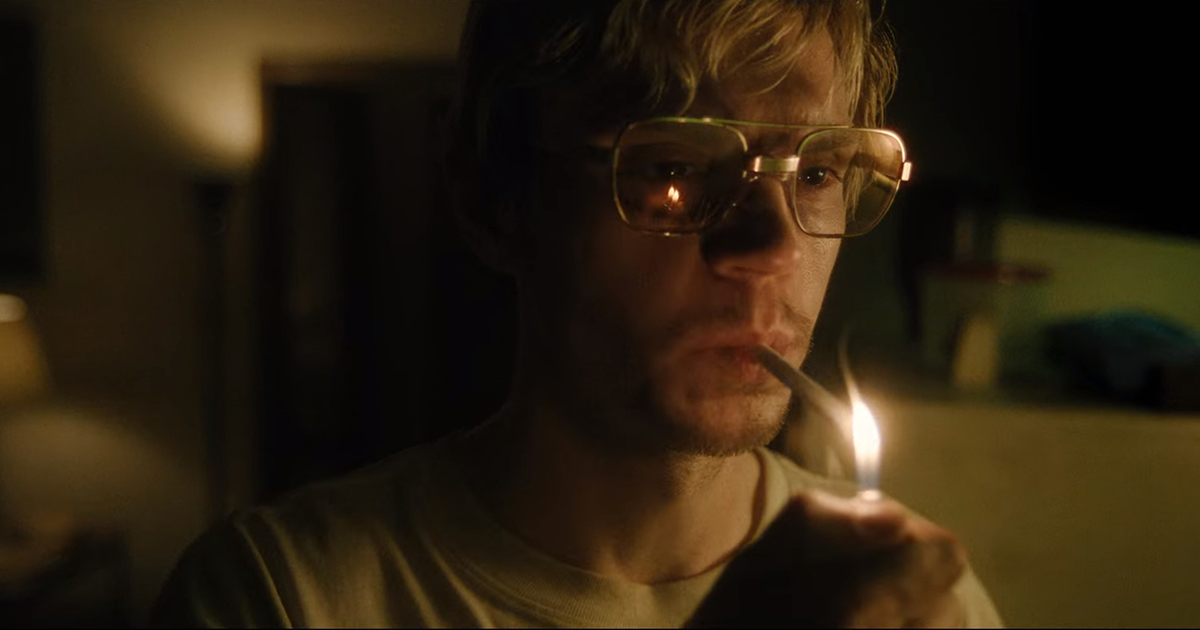
Smoking imagery in streaming shows leads to vaping nicotine
While a robust body of research has directly linked tobacco imagery in movies to increased smoking among young people, a groundbreaking Truth Initiative study published in Preventive Medicine was the first to establish a link between smoking imagery and e-cigarette use. Youth and young adults with high exposure to popular streaming and TV shows containing tobacco images are three times more likely to start vaping compared to their peers with no exposure. Higher exposure and younger viewer age was also linked with increased likelihood of starting to use e-cigarettes.
Nearly all (99.3%) tobacco imagery in streaming shows examined in the 2020 study were combustible tobacco products like cigarettes and cigars. The story hasn’t changed in 2022: 98% of tobacco depictions in popular and binge-watched 2022 shows featured combustible cigarettes, cigars, and pipes. While most on-screen depictions feature cigarettes and smoking, the behavior it can fuel among young people is toward e-cigarettes. Young people may be imitating the behavior of smoking, but with the more popular product among their generation.
TOBACCO DEPICTIONS SKYROCKET AMONG BINGE-WATCHED SHOWS
Binge-watched shows deserve special attention because of the intense, high-volume exposure to tobacco content. A 2020 survey by Statista found that 60% of respondents between 13-17 and 69% of respondents between 18-29 binge-watch shows or movies frequently.
To capture this source of tobacco imagery, Truth Initiative researchers analyzed current seasons of the top binge-watched shows among young people since 2020. Researchers asked young people which streaming shows that had new seasons in 2022 they binge-watched, then coded the 2022 season for tobacco imagery. To measure if young people are continuously watching older shows with tobacco, researchers also asked young people which previously coded streaming shows flagged as tobacco offenders they have binge-watched. (See “Methods for Show Selection and Analysis” on page 20 for a full list of shows.)
The number of binge-watched shows containing tobacco imagery increased from 56% to 64% in 2022. The number of tobacco incidents among the most binge-watched streaming shows nearly quadrupled from 537 to 2,002 incidents, in part because of BBC One’s “Peaky Blinders,” which contains 893 incidents in its sixth season alone, setting the record for most incidents in a single season since Truth Initiative began tracking tobacco depictions in shows. The 2022 seasons of the binge-watched shows “Euphoria,” “The Simpsons,” “The Boys,” “Snowfall,” “Better Call Saul,” and “Stranger Things” also depicted tobacco.
“Peaky Blinders” and “Snowfall” featured tobacco imagery in all episodes of their 2022 seasons. The second full season of the Emmy- and Golden Globe-winning show “Euphoria” featured 200 tobacco depictions, down from 312 in its first season. Tobacco depictions in “The Simpsons” more than doubled from 75 in 2021 to 195 in 2022.
Truth Initiative researchers also found that many young people continue to watch shows flagged in previous years as tobacco offenders. In 2022, more than half of young people reported watching popular previous tobacco-offenders like “SpongeBob SquarePants,” “Stranger Things,” “Family Guy,” “Squid Game,” and “The Simpsons.” Young people have vast libraries of popular streaming content rife with tobacco imagery available at their fingertips – a major concern given the tendency to binge-watch popular shows and links between exposure and tobacco use.
Tobacco exposure through YouTube and other social platforms
Social media is a popular way young people watch video content. About nine in 10 U.S. teens say they use YouTube, the top social platform, according to a 2023 Pew Research Center survey. A Truth Initiative study currently underway seeks to determine if teens and young adults are exposed to tobacco content on YouTube, TikTok, and Twitch – three of the most popular user-generated content platforms with young people today. The study finds that more than a third of respondents who used each of these platforms reported exposure to tobacco imagery. Results from the study are being prepared for publication in a peer-reviewed journal.
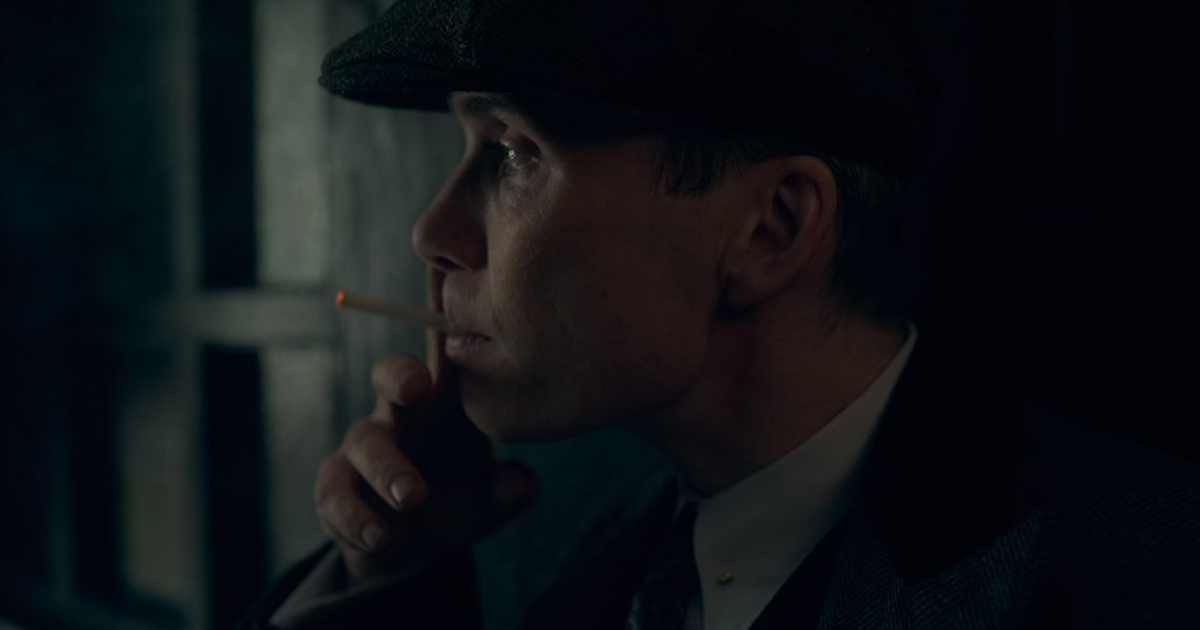
PAST NETWORK OFFENDERS INCREASE TOBACCO CONTENT
Six out of seven networks (Netflix, Fox, HBO, AMC, CW, FX) that displayed tobacco imagery in 2021 and had popular shows in 2022 increased tobacco imagery in their 2022 programming. BBC One joined the list as top offender thanks to “Peaky Blinders.” Last year’s top network offender, Showtime, did not have a show that ranked among the most popular shows this year, and its top-offending show last year, “Shameless” ended the series in 2021. Amazon Prime Video made the list this year with the show “The Boys,” produced by Amazon, featuring 193 tobacco depictions.
Netflix and Fox held steady in the second and third spots but more than doubled their depictions from last year: Netflix moved from 157 to 429, and Fox moved from 97 to 241. These increases are driven in part by “Dahmer – Monster: The Jeffrey Dahmer Story” and “The Simpsons,” respectively. Despite a 2019 pledge to eliminate tobacco in original, youth-rated shows and movies that are not historical, Netflix continues to include tobacco depictions in shows popular with young people, such as “Cobra Kai,” which is rated TV-14. Fox featured twice as much tobacco imagery in the animated, repeat-offender “The Simpsons.”
Platforms that choose to distribute shows that contain tobacco imagery are magnifying the content’s impact. For example, U.S. audiences can access the BBC One’s “Peaky Blinders” by streaming it on Netflix, Amazon Prime Video, and Apple TV. Disney+ streams Fox’s “The Simpsons” despite strict policies against tobacco imagery in Disney’s original programming. Networks must take responsibility for the potential health impacts of any shows they decide to distribute, regardless of whether it is original to the network.
Rehashing tobacco’s past
Biographical and period shows ranked among the top 15 and most binge-watched shows this year. These shows include “Peaky Blinders,” a fictional period drama based on a British youth gang active in the 1880s through the 1910s; “Dahmer – Monster: The Jeffrey Dahmer Story,” a biography of serial killer Jeffrey Dahmer, set between 1978–1991; “Snowfall,” a series that explores the history of the 1980s crack epidemic and its impact on Los Angeles; and “Stranger Things,” a science fiction horror drama set in the 1980s.
These shows included copious tobacco imagery: “Peaky Blinders” featured 893 depictions, “Dahmer – Monster: The Jeffrey Dahmer Story” featured 306 depictions, “Snowfall” featured 104 depictions, and “Stranger Things” contains 89 depictions – though notably less than the 721 depictions of its third season.
In 2019, Netflix announced that none of its new, original, youth-rated programming would contain smoking or e-cigarettes, “except for reasons of historical or factual accuracy.” By repeatedly representing smoking from the past, shows put youth at risk for initiating tobacco use today. This should not be a case where history repeats itself. Shows and films can create a sense of the past through costumes, hair and makeup, props, and set design without relying on cigarettes as a crutch. Directors should look for creative alternatives. According to Smoke Free Media’s Onscreen Tobacco Database, “The Greatest Showman,” “Hidden Figures,” “Secretariat,” and “Invictus” are all films set in the past that ranked among the top 10 theatrical releases for at least a week and do not feature tobacco imagery.
UNDERAGE CHARACTERS LIGHT UP
Three of this year's most popular and top binge-watched shows of this year’s most popular shows featured tobacco use by minors. HBO’s “Euphoria” features tobacco use by characters under 18, including by star Hunter Schafer, who plays 17-year-old Jules Vaughn. Netflix’s animated show “Big Mouth” depicts tobacco as fun and relaxing and features tobacco use by minors. “Law & Order” features two extras under 18 smoking to relax in a park near children.
Pretend props with real risks
Portraying tobacco on-screen is harmful to more than just the people watching at home. BBC One’s period drama “Peaky Blinders” earned the distinction of being the binge-watched show with the most tobacco imagery in 2022 with a whopping 893 cigarettes, cigars, and pipes in its sixth season alone. Cillian Murphy, who played the lead in “Peaky Blinders” as well as the summer blockbuster “Oppenheimer,” told The Guardian, “I’ve smoked so many fake cigarettes for Peaky and [“Oppenheimer”]. My next character will not be a smoker. They can’t be good for you. Even herbal cigarettes have health warnings now.”
Actors should be empowered to put down cigarettes – herbal and otherwise, on set and on screen – for their own health and for the health of their viewers.
SMOKING IN YOUTH-RATED AND ANIMATED SHOWS
As in past years, 2022 shows that are rated appropriate for youth, as well as animated shows, contained tobacco imagery. Among the top 15 shows, four TV-14-rated shows featured tobacco: “The Simpsons,” “Stranger Things,” “Bob’s Burgers,” and “Law & Order SVU.” The Emmy-winning fourth season of “Stranger Things” is Netflix’s second most popular show of all time based on views in the first 91 days, as of October 2023.
Animated shows are more popular with young people than with any other demographic. According to Ypulse’s Media Consumption Report, 36% of Gen Z people surveyed watch cartoons each week, compared with 26% of millennials. The animated shows among the top 15 that contained tobacco imagery – "The Simpsons,” “Bob’s Burgers,” and “Family Guy” – all increased the number of tobacco portrayals this year. In fact, tobacco depictions in “The Simpsons” more than doubled, from 75 in its 2021 season to 195 in its 2022 season. In addition, “All American,” “Big Mouth,” “American Dad,” and “SpongeBob SquarePants” are frequently binge-watched animated shows that contain tobacco imagery. “SpongeBob SquarePants” is rated TV-Y7.

Some shows make strides
Some shows reduced or eliminated tobacco depictions this year. “Big Mouth” and “Bob’s Burgers” decreased their numbers of tobacco depictions. The fourth season of “Stranger Things” contained 89 depictions, down from a whopping 721 in its third season. “Riverdale,” which had three tobacco depictions in its previous season, eliminated tobacco depictions this year.
The 2022 season of “Rick & Morty” displayed no tobacco imagery, down from four incidents in 2021. Actor and comedian Chris Parnell, who voices Jerry Smith on “Rick & Morty,” recently lent his voice to the new animated truth® campaign “Toxic Therapy from Your Vape.” In the campaign, which sheds light on the misconception that vaping nicotine helps alleviate stress and anxiety, Parnell voices a vape-turned-faux-therapist who recommends unhealthy responses to stress.
Animated short videos including “Texting Anxiety,” “Hypnotherapy,” and “Sleep Exercises,” underscore the connection between nicotine addiction and mental health, each featuring the Toxic Therapist character impersonating a therapist offering unhealthy and detrimental advice during moments of stress. For example, when friends don’t respond to text messages, the Toxic Therapist encourages individuals to jump to conclusions and believe their friends are excluding them. Similarly, when struggling to sleep due to past embarrassments, the Toxic Therapist advises individuals to dwell on these thoughts until sunrise, vividly illustrating how vaping nicotine can increase feelings of anxiety rather than help with coping.
SPOTLIGHT ON VAPING E-CIGARETTES
Cigarettes continue to be the most common tobacco product depicted. Vaping depictions in the top 15 and most binge-watched shows held steady at 2% of all depictions across the top 15 shows this year. The HBO teen drama “Euphoria” was responsible for almost all vaping depictions among the top 15 shows and more than half of depictions among the most binge-watched shows. Amazon Prime Video’s superhero satire “The Boys” and the CW cartoon “American Dad” made up the remainder.
E-cigarettes gained ground in a few notable places this year: “Glass Onion: A Knives Out Mystery” became the first youth-rated movie in NORC’s analysis to feature an e-cigarette, and top music videos portrayed e-cigarettes 27 times in 2022, compared to just once in 2021.
TOBACCO DEPICTIONS IN MOVIES DIP
The link between tobacco in movies and real-life tobacco use is clear. A 2012 U.S. Surgeon General’s report found that tobacco depictions in movies cause young people to start smoking. Multiple studies have established a dose-response relationship: the more imagery young people are exposed to, the more likely they are to start smoking.
Encouragingly, tobacco imagery in movies declined from 2021 to 2022, according to the report “Smoking in Films: 2022” from NORC at the University of Chicago, which analyzed tobacco depictions in top 2022 movies. Over a third (35%) of films released in 2022 contained tobacco imagery (40 out of 114 films), compared with 47% (53 out of 112 films) in 2021, and the total number of tobacco incidents (1,167) decreased by half compared to 2021. Movies exposed an estimated 21 million young people ages 15-24 to tobacco imagery in streaming films, down from 25 million in 2021.
No film rated PG-13 or below should contain tobacco, and yet 40% of all movies with tobacco were rated appropriate for youth. Four PG-rated films – “Brian and Charles,” the rerelease of 1946’s “It’s a Wonderful Life,” “Mr. Malcolm’s List,” and “Mrs. Harris Goes to Paris” – contained tobacco imagery, up from the one PG-rated movie to include tobacco in 2021, “The Girl Who Believed in Miracles.” The number of incidents in these movies climbed from 8 to 103. No G-rated movies contained tobacco. This increase in tobacco imagery in PG-rated films is a disturbing setback. Studios need to do more to keep tobacco imagery out of youth-rated films.
The top 16 movies containing tobacco that were rated PG-13 or under are:
- Brian and Charles, PG
- Devotion, PG-13
- Dragon Ball Super: Super Hero, PG-13
- Glass Onion: A Knives Out Mystery, PG-13
- It’s a Wonderful Life (rerelease), PG
- Moonage Daydream, PG-13
- Mr. Malcolm’s List, PG
- Mrs. Harris Goes to Paris, PG
- One Piece Film: Red, PG-13
- Redeeming Love, PG-13
- The Fabelmans, PG-13
- The Lost City, PG-13
- The Woman King, PG-13
- Till, PG-13
- Uncharted, PG-13
- Whitney Houston: I Wanna Dance with Somebody, PG-13
None of the top five films watched by young people surveyed contained tobacco, proving that movies don’t need tobacco to be popular with young people.

Oscar nominees continue to light up
Almost all films nominated for a 2024 Oscar for Best Picture – nine of the 10 films, all except “Barbie” – feature tobacco imagery. They include “Maestro,” “The Holdovers,” “Oppenheimer,” “American Fiction,” “Killers of the Flower Moon,” “Poor Things,” “Anatomy of a Fall,” “The Zone of Interest,” and “Past Lives.”
Last year, seven of the 10 films (70%) nominated for Best Picture included tobacco. Well established research shows exposure to smoking in movies causes young people to start using tobacco, a conclusion reached almost a decade ago in a 2012 Surgeon General report. A more recent study published in Preventive Medicine found that exposure to onscreen smoking imagery can triple a young person’s odds of starting to vape nicotine.
Two of the Best Picture nominees – “The Zone of Interest,” and “Past Lives” – are rated PG-13. Notably, a nominee for Best Animated Feature Film – “The Boy and the Heron,” rated PG-13 – also features smoking.
Awards such as the Oscars, Golden Globes, and Emmys garner movies and shows prestige, media attention, and increased viewership. Oscar-winning films sometimes get a second or expanded run in movie theaters and shows that win awards may be more likely to be renewed for more seasons.
TWICE AS MANY MUSIC VIDEOS FEATURE TOBACCO
Tobacco imagery in popular music videos was on the rise in 2022. Analysis of the top 2022 Billboard songs revealed that 28% (60 of 212) of songs with music videos contained 462 depictions and were viewed almost 7 billion times. This is a dramatic increase from 12.8% of music videos containing 290 depictions and garnering 2 billion views in 2021. “Smokin Out the Window” by Anderson.Paak, Bruno Mars, and Silk Sonic and “El Incomprendido” by Farruko once again topped the list of music videos featuring tobacco imagery, with 109 and 55 incidents, respectively. “Smokin Out the Window” received 175 million views. These songs were followed by Nazareno by Farruko (with 39 tobacco depictions), “Drunk (And I Don’t Wanna Go Home)” by Elle King and Miranda Lambert (27) – another holdover from last year – and “Heyy” by Lil Baby (15).
Once again, Hot R&B/Hip-Hop is the genre with the most depictions: tobacco made 265 appearances in nearly half (45%) of R&B/hip-hop music videos. Hot 100 came in second, with 31% of music videos and 81 incidents. Cigarettes remain the most popular tobacco product depicted, but music videos in 2022 featured 27 depictions of e-cigarettes, compared to only one in 2021.
While the age of individual viewers for music videos is unknown, the medium is of concern because music videos are easy to watch on a phone without parental oversight. And as with binge-watched shows, the sustained popularity of these videos from year to year demonstrates tobacco content continues to do damage long after it is released into the world.

The inclusion of tobacco in PG-rated films and skyrocketing tobacco use in streaming shows and music videos continues to expose too many young people to tobacco, putting them at risk of nicotine addiction.
SNUFFING OUT ON-SCREEN TOBACCO
Tobacco imagery has been stubbornly present in media most popular with youth, despite years of research tying on-screen tobacco depictions on-screen to youth tobacco use. While Truth Initiative applauds movie studios and the networks who have reduced tobacco imagery in their programming, the continued inclusion of tobacco in PG-rated films and skyrocketing tobacco use in streaming shows and music videos continues to expose too many young people to tobacco, putting them at risk of nicotine addiction especially given the high levels of nicotine contained in e-cigarette brands most popular with youth. A 2023 study of trends in nicotine strength among e-cigarette products found that the average concentration of nicotine in e-cigarettes has increased from 2.5% to 4.4% between 2017 and 2022.
Progress among streaming services has been slow. In 2019, Netflix announced that, with a few exceptions, none of its new, original, youth-rated programming would contain smoking or e-cigarettes, and it would curtail tobacco use in adult-rated programming. In 2019 and 2020, groups of state attorneys general sent letters to major streaming services, including Netflix, and to writers’ guilds urging them to take steps to protect young people from tobacco imagery. In March 2022, Senators Edward J. Markey, Chris Van Hollen and Richard Blumenthal urged Netflix to decrease tobacco content it its streaming shows. After season four of “Stranger Things” premiered in 2022, Truth Initiative wrote Netflix a letter from a coalition of 16 public health and research organizations to encourage the company to make good on its 2019 promise. Truth Initiative also recognizes that the harm caused by tobacco exposure by the entertainment industry and the struggle to rein in exposure extends beyond the U.S. In 2022, Truth Initiative shared work on tobacco imagery in entertainment at the WHO Framework Convention on Tobacco Control Secretariat.
As of this report’s writing, although Netflix has engaged with Truth Initiative in response to the letters, it continues to produce tobacco-laden shows: Netflix’s “Dahmer – Monster: The Jeffrey Dahmer Story” contained the most depictions in a top 15 show, and “Cobra Kai,” a TV-14 show, also features tobacco. Disney, meanwhile, continues to distribute new seasons of shows rife with increasing amounts of tobacco imagery: Disney+ distributes Fox’s “The Simpsons” on its streaming platform despite a strict policy curtailing tobacco in its original programming.
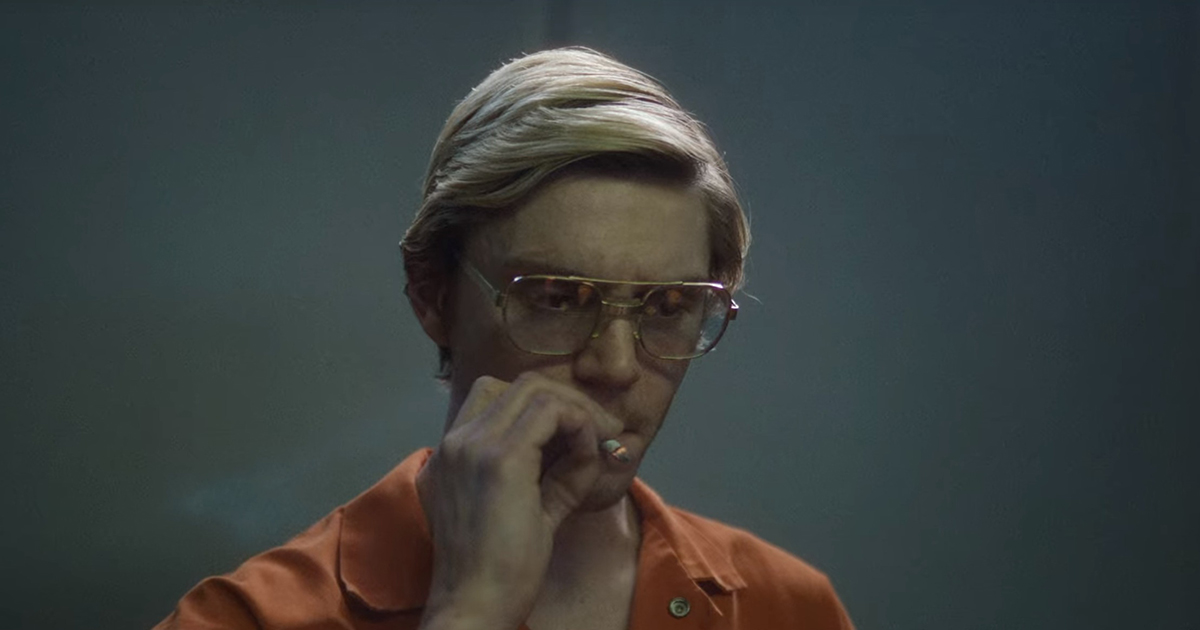
This lack of progress shows that raising awareness is not enough. As gaming and user-generated content eclipses movies and streaming shows as the default at-home entertainment, young people’s media consumption – and their exposure to tobacco – will become increasingly difficult to monitor. In addition to pressuring entertainment companies to take necessary steps to protect young people from tobacco imagery, we also need to educate and call on actors, creators, and showrunners directly to make meaningful progress.
To truly address youth exposure to tobacco imagery, Truth Initiative calls for a comprehensive set of policies to curb tobacco depictions on screens, including:
- Developing and publicizing anti-smoking policies – Studios should develop policies that restrict tobacco content in youth-rated films similar to those in effect among members of the Motion Picture Association. Non-MPA member studios continue to be the top offenders regarding tobacco depictions, producing 75% of PG-rated films that contained tobacco in 2022. Studios should hold themselves accountable by making these policies public.
- Enveloping existing tobacco content in anti-smoking messages – Anti-tobacco and anti-vaping ads are successful at reducing tobacco use and should appear before and after shows that contain tobacco imagery. Similar to how networks and streaming companies handle portrayals of eating and mental health disorders, youth-rated shows that contain tobacco imagery should feature static screen shots with anti-smoking and anti-vaping messages that point them to evidence-based resources, such as Truth Initiative’s text-message quit vaping program This is Quitting.
- Increasing awareness and outreach – Increase awareness that portraying tobacco on-screen risks leading young people to a lifetime of tobacco addiction. Public health organizations should focus on parents and young people, as well as public officials and creative stakeholders such as directors, writers, producers, and actors. Educate people with wide-reaching platforms, such as actors, musicians, and influencers, who can help spread this message.
- Empowering actors not to portray tobacco – Actors who understand the harmful effects of on-screen tobacco use could include “no tobacco” clauses in their contracts. If a scene involves tobacco use, SAG-AFTRA could require a “tobacco rider,” similar to the nudity riders used in actors’ contracts today, that outlines the parameters of tobacco use and includes appropriate warnings about the health impacts of prop cigarettes and the impact of tobacco imagery on young audiences. In the same vein, show runners and content developers should be encouraged to understand the connection between tobacco imagery and youth tobacco use and choose not to include such imagery over the health of young people.
- Modernizing ratings systems and parental controls – Movies and shows that portray tobacco use should be rated R and TV-MA. An R rating could disincentivize studios from including tobacco content. Streaming services deserve special attention because young people now primarily access new movies through streaming. These services should streamline ratings and make them highly visible before the user has selected a program, as well as streamlining and strengthening parental controls.
- Monitoring compliance with existing regulations – A ban on paid tobacco product placements in movies and shows was codified into federal law in 2009, but shows and movies continue to provide free advertising for the tobacco industry today. The film industry must certify that tobacco companies did not exchange anything of value for depictions of smoking or vaping in a show or movie. Furthermore, studios must cooperate with restrictions that prevent films that contain tobacco from qualifying for local tax breaks and other incentives.
More in tobacco in pop culture
Want support quitting? Join EX Program
By clicking JOIN, you agree to the Terms, Text Message Terms and Privacy Policy.
Msg&Data rates may apply; msgs are automated.








